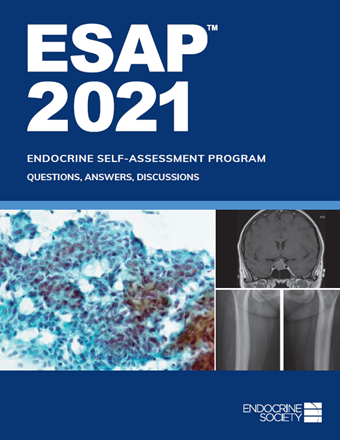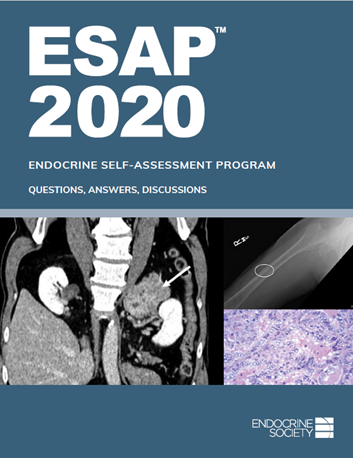Updates to ESAP can be found on this page.

Diabetes
Page(s): 19
Updated: 02 September 2025
Update Summary: Patient's list of medications is now accurate for someone with Type 1 Diabetes.
Information as Originally Published:
A 64-year-old man with a 10-year history of type 1 diabetes presents to establish care. He plans to go on a cruise in 3 months. He reports good glycemic control, and his most recent hemoglobin A1c value is 7.3% (56 mmol/mol). Current medications are metformin, pioglitazone, glipizide, and atorvastatin. He has been vaccinated for COVID-19 but has not received a booster. He is worried about risk of infection on the cruise. He is unsure of other vaccination history, although he has had all childhood vaccinations. He was infected with chickenpox as a child and had pneumonia 4 years ago.
Information as Currently Updated:
A 64-year-old man with a 10-year history of type 1diabetes presents to establish care. He plans to go on a cruise in 3 months. He reports good glycemic control, and his most recent hemoglobin A1c value is 7.3% (56 mmol/mol). Current medications are insulin glargine and insulin aspart. He has been vaccinated for COVID-19 but has not received a booster. He is worried about risk of infection on the cruise. He is unsure of other vaccination history, although he has had all childhood vaccinations. He was infected with chickenpox as a child and had pneumonia 4 years ago.
Obesity
Page(s): 98
Updated: 02 September 2025
Information as Originally Published:
Table. FDA-Approved Weight-Loss Medications
| Drug and dosage | Year approved | Mean placebo-subtracted weight loss, % in randomized controlled trials |
| Orlistat, 120 mg 3 times daily | 1999 | 4.0 |
| Phentermine/topiramate, 15/92 mg once daily | 2012 | 8.7 |
| Naltrexone/bupropion, 8/90 mg two tablets twice daily | 2014 | 4.8 |
| Liraglutide, 3 mg once weekly subcutaneously | 2014 | 5.4 |
| Semaglutide, 2.4 mg once weekly subcutaneously | 2021 | 12.4 |
| Semaglutide, 3 mg once daily subcutaneously | 2020, 2022 (Bardet-Biedl syndrome | NA |
| Tirzepatide, 15 mg once weekly subcutaneously | 2023 | 17.8 |
Information as Currently Updated:
Table. FDA-Approved Weight-Loss Medications
| Drug and dosage | Year approved | Mean placebo-subtracted weight loss, % in randomized controlled trials |
| Orlistat,120 mg3 times daily | 1999 | 4.0 |
| Phentermine/topiramate, 15/92 mg once daily | 2012 | 8.7 |
| Naltrexone/bupropion, 8/90 mg two tablets twice daily | 2014 | 4.8 |
| Liraglutide, 3 mg once daily subcutaneously | 2014 | 5.4 |
| Semaglutide, 2.4 mg once weekly subcutaneously | 2021 | 12.4 |
| Semaglutide,3 mg once daily subcutaneously | 2020, 2022 (Bardet-Biedl syndrome | NA |
| Tirzepatide,15 mg once weekly subcutaneously | 2023 | 17.8 |

Thomas Weber, MD
Bone; pp. 14-15
Update date: April 28, 2022
Summary of Update: Laboratory values have been updated to include an estimated glomerular filtration rate.
Information as Originally Published:
“Laboratory test results (serum):
Calcium = 9.5 mg/dL (8.2-10.2 mg/dL) (SI: 2.4 mmol/L [2.1-2.6 mmol/L])
Phosphate = 3.5 mg/dL (2.3-4.7 mg/dL) (SI: 1.1 mmol/L [0.7-1.5 mmol/L])
Creatinine = 1.6 mg/dL (0.7-1.3 mg/dL) (SI: 141.4 μmol/L [61.9-114.9 μmol/L])
Albumin = 4.0 g/dL (3.5-5.0 g/dL) (SI: 40 g/L [35-50 g/L])
Intact PTH = 70 pg/mL (10-65 pg/mL) (SI: 70 ng/L [10-65 ng/L])
25-Hydroxyvitamin D = 25 ng/mL (30-80 ng/mL [optimal]) (SI: 62.4 nmol/L [74.9-199.7 nmol/L])
Urinary calcium excretion = 300 mg/24 h (100-300 mg/24 h) (SI: 7.5 mmol/d [2.5-7.5 mmol/d])
Urinary creatinine excretion = 1.2 g/24 h (1.0-2.0 g/24 h) (SI: 10.6 mmol/d [8.8-17.7 mmol/d])”
Information as Currently Updated:
“Laboratory test results (serum):
Calcium = 9.5 mg/dL (8.2-10.2 mg/dL) (SI: 2.4 mmol/L [2.1-2.6 mmol/L])
Phosphate = 3.5 mg/dL (2.3-4.7 mg/dL) (SI: 1.1 mmol/L [0.7-1.5 mmol/L])
Creatinine = 1.6 mg/dL (0.7-1.3 mg/dL) (SI: 141.4 µmol/L [61.9-114.9 µmol/L])
Estimated glomerular filtration rate = 15 mL/min per 1.73 m2 (>60 mL/min per 1.73 m2)
Albumin = 4.0 g/dL (3.5-5.0 g/dL) (SI: 40 g/L [35-50 g/L])
Intact PTH = 70 pg/mL (10-65 pg/mL) (SI: 70 ng/L [10-65 ng/L])
25-Hydroxyvitamin D = 25 ng/mL (30-80 ng/mL [optimal]) (SI: 62.4 nmol/L [74.9-199.7 nmol/L])
Urinary calcium excretion = 300 mg/24 h (100-300 mg/24 h) (SI: 7.5 mmol/d [2.5-7.5 mmol/d])
Urinary creatinine excretion = 1.2 g/24 h (1.0-2.0 g/24 h) (SI: 10.6 mmol/d [8.8-17.7 mmol/d])”
Kevin Pantalone, DO
Diabetes; pp. 102-103
Update date: April 28, 2022
Summary of Update: The list of scenarios for when to consider monogenic diabetes has been updated to reflect that a family history is not always present if the patient has a de novo pathogenic variant.
Information as Originally Published:
“Monogenic diabetes should be considered if the features listed below are present in patients initially thought to have type 1 diabetes:
Information as Currently Updated:
“Monogenic diabetes should be considered if the features listed below are present in patients initially thought to have type 1 diabetes:
Summary of Update: A note has been added to the discussion to reflect evolving data that suggest that semaglutide could also be considered a correct answer choice in this setting.
Information as Originally Published: “Stopping evolocumab or the statin (Answers A and B) is incorrect, as this would result in increased LDL-cholesterol levels in this patient who is at very high risk. Decreasing the rosuvastatin dosage from 40 mg to 20 mg daily (which is still considered high-intensity statin therapy) would be reasonable, but it was not offered as an answer option. Fenofibrate is a peroxisome proliferator–activated receptor α agonist with triglyceride-lowering effects. Stopping fenofibrate (Answer C) would most likely result in increased triglycerides. PCSK9 inhibitors do not have any significant triglyceride-lowering capability. The fibrate should be continued for now and ongoing need should be reassessed at a later time. Semaglutide (Answer D) is a GLP-1 receptor agonist with cardiovascular benefit used in individuals for treatment of type 2 diabetes. This patient’s hemoglobin A1c level is currently optimal.
At this time, no change in the patient’s treatment regimen is necessary (Answer E).”
Information as Currently Updated: “Stopping evolocumab or the statin (Answers A and B) is incorrect, as this would result in increased LDL-cholesterol levels in this patient who is at very high risk. Decreasing the rosuvastatin dosage from 40 mg to 20 mg daily (which is still considered high-intensity statin therapy) would be reasonable, but it was not offered as an answer option. Fenofibrate is a peroxisome proliferator–activated receptor α agonist with triglyceride-lowering effects. Stopping fenofibrate (Answer C) would most likely result in increased triglycerides. PCSK9 inhibitors do not have any significant triglyceride-lowering capability. The fibrate should be continued for now and ongoing need should be reassessed at a later time. *Semaglutide (Answer D) is a GLP-1 receptor agonist with cardiovascular benefit used in individuals for treatment of type 2 diabetes. This patient’s hemoglobin A1c level is currently optimal.
At this time, no change in the patient’s treatment regimen is necessary (Answer E).
* Since the time this vignette was written, more evidence has been reported supporting the use of semaglutide in this setting, and it could also be considered a correct answer, assuming the patient is willing to add yet another medication.”
Information as Originally Published: “Polyunsaturated fats are found in high concentrations in corn oil, soybean oil (Answer A), safflower oil high in linoleic acid, and sunflower oil high in linoleic acid (high linoleic acid varieties of oils are uncommon). Monounsaturated fats are found in high concentrations in canola oil, olive oil (Answer C), peanut oil, safflower oil high in oleic acid, and sunflower oil high in oleic acid.
This patient would benefit from using an oil high in polyunsaturated fatty acids (e.g., soybean oil [Answer A]).”
Information as Currently Updated: “Polyunsaturated fats are found in high concentrations in corn oil, soybean oil (Answer A), safflower oil (high in linoleic acid), and sunflower oil (high in linoleic acid) (high linoleic acid varieties of oils are uncommon). Monounsaturated fats are found in high concentrations in canola oil, olive oil (Answer C), peanut oil, safflower oil (high in oleic acid), and sunflower oil (high in oleic acid). Oils rich in polyunsaturated fats (e.g., soybean oil) are better for lowering cardiovascular disease risk than oils rich in monounsaturated fats. Of the given answer options, this patient would be expected to benefit from using soybean oil.”
Information as Originally Published: Although dietary counseling (Answer A) to help her make better food choices is a good idea, and the addition of glimepiride (Answer D) might lower her blood glucose, the unexpected rise in hemoglobin A1c with no identifiable cause should prompt evaluation for a secondary etiology.
Information as Currently Updated: While adding insulin (Answer A) or glimepiride (Answer D) could address her hyperglycemia, the unexpected rise in hemoglobin A1c with no identifiable cause should prompt evaluation for a secondary etiology.
Updated Information—At the time this question was written, SGLT-2 inhibitors were contraindicated in patients with an estimated glomerular filtration rate less than 30 mL/min per 1.73 m2. However, more recent trial evidence has supported the use of these drugs, even in stage 4 chronic kidney disease. Thus, Answer A could also be considered correct at this time.
Savitha Subramanian, MD
Lipids-Obesity; pp. 36-37
Update date: August 5, 2021
Updated Information—New guidelines released since this question was written have provided an alternative correct answer. The 2021 American Diabetes Association guidelines would now recommend adding a GLP-1 receptor agonist or an SGLT-2 inhibitor in this setting, regardless of hemoglobin A1c, due to the additional cardiovascular risk benefit. Thus, Answer D could also be considered correct at this time.

Mathis Grossmann, MD, PhD, FRACP
Male Reproduction; p. 96
Update date: August 26, 2020
Information as originally published: Assessing free testosterone is indicated when total testosterone concentrations are borderline, or if conditions that alter SHBG are suspected, such as increased levels with obesity, diabetes mellitus, use of exogenous androgens, or hypothyroidism or decreased levels with aging, hyperthyroidism, liver disease, anticonvulsant medications, HIV, or use of estrogens.
Information as currently updated: Assessing free testosterone is indicated when total testosterone concentrations are borderline, or if conditions that alter SHBG are suspected, such as decreased levels with obesity, diabetes mellitus, use of exogenous androgens, or hypothyroidism or increased levels with aging, hyperthyroidism, liver disease, anticonvulsant medications, HIV, or use of estrogens.
Savitha Subramanian, MD
Lipids/Obesity; pp. 23-24
Update date: August 26, 2020
Information as originally published: Fasting plasma glucose: 78 mg/dL (70-99 mg/dL) (SI: 7.3 mmol/L)
Information as currently updated: Fasting plasma glucose: 78 mg/dL (70-99 mg/dL) (SI: 4.3 mmol/L)
Thomas J. Weber, MD
Bone and Mineral Metabolism; pp. 65-66
Update date: August 26, 2020
Information as originally published: Urinary creatinine = 1.2 mg/24h (1.0-2.0 g/24h)
Information as currently updated: Urinary creatinine = 1.2 g/24h (1.0-2.0 g/24h)
Thomas J. Weber, MD
Bone and Mineral Metabolism; pp. 75-76
Update date: August 26, 2020
Information as originally published: Urinary creatinine = 1.0 mg/24h (1.0-2.0 g/24h)
Information as currently updated: Urinary creatinine = 1.0 g/24h (1.0-2.0 g/24h)